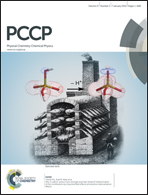Molecular insight into nanoscale water films dewetting on modified silica surfaces
Abstract
In this work, molecular dynamics simulations are adopted to investigate the microscopic dewetting mechanism of nanoscale water films on methylated silica surfaces. The simulation results show that the dewetting process is divided into two stages: the appearance of dry patches and the quick contraction of the water film. First, the appearance of dry patches is due to the fluctuation in the film thickness originating from capillary wave instability. Second, for the fast contraction of water film, the unsaturated electrostatic and hydrogen bond interactions among water molecules are the driving forces, which induce the quick contraction of the water film. Finally, the effect of film thickness on water films dewetting is studied. Research results suggest that upon increasing the water film thickness from 6 to 8 Å, the final dewetting patterns experience separate droplets and striation-shaped structures, respectively. But upon further increasing the water film thickness, the water film is stable and there are no dry patches. The microscopic dewetting behaviors of water films on methylated silica surfaces discussed here are helpful in understanding many phenomena in scientific and industrial processes better.


 Please wait while we load your content...
Please wait while we load your content...